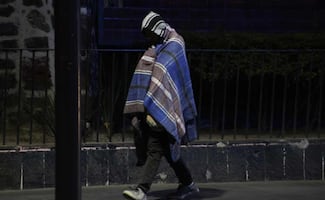Más Información

Lesli, la conexión entre el "Tren de Aragua" y "La Unión Tepito"; así fungía como negociadora entre los grupos criminales

Otorgan nueva prórroga a acusado de acoso contra la presidenta Claudia Sheinbaum; seguirá preso en el Reclusorio Norte

Frente frío 27 provocará temperaturas de hasta -15 grados en el país; SMN prevé lluvias y vientos fuertes

¿Vigilarán a las personas con el registro de celulares?; Sheinbaum explica para qué funciona esta medida
Leer en español
The secrets of Teotihuacán are still underground. During an exploration, researchers from the National Anthropology and History Institute (INAH) and the Geophysics Institute from the UNAM identified a chamber just 26 feet underground and a tunnel under the Moon Pyramid in Teotihuacán .
The pit, which could be a funerary space, is 49 feet in diameter and leads to the Moon Square . According to Verónica Ortega , director of the Project for the Integral Conservation of the Moon Square, the materials found in the chamber will be used to determine who controlled those buildings, the political relations in Teotihuacán , as well as who was sacred.
The experts carried out a resistivity test and an electric tomography , a non-invasive method, to identify these chambers.
“These findings have allowed identifying that for the people of Teotihuacán , besides building monuments and building a well-planned city, it was important to carry out works underground: excavating large holes, placing offerings inside, give public spaces a more ritual sense, as well as to their large public squares. Their works go beyond the monumental part, they also have a symbolic complex underground .”
This study will allow corroborating that there is a sacred pattern underneath the great monuments in the city. It also looks to compare the type of rituals carried out in each building, and with the materials found, find more information about who they were dedicated to.
“We think that the large buildings were dedicated to aquatic gods. The Mexicas said that they were the Moon and Sun pyramids , now we realize the Sun pyramid was dedicated to Tláloc and the Moon pyramid is probably dedicated to Chalchiuhtlicue , the goddess of the waters on earth.” This theory has been reinforced by the findings made by the archeologists Rubén Cabrera and Saburo Sugiyama in the 80s when they found offerings linked with the aquatic cult.
The researchers say that very little is known about Teotihuacán and that any new information will allow to “give a closer explanation to reality, in contrast with what was left by colonial chronicles that seem to confuse many times, rather than providing certainty.”
In 2016, during an excavation near the Moon pyramid , two green stone sculptures were found. “Here we found the two biggest sculpture dedicated to Chalchiuhtlicue . Her presence talks about an aquatic cult because it's related to fertility and abundance , and reinforces our theory that the Moon pyramid and its square were dedicated to this goddess ,” she explains.
The materials, the key
The Moon pyramid had great importance for this culture. Ortega explains that the building was built in 7 construction stages and that there were great rituals during each of them: sumptuous offerings which included human and animal sacrifices that symbolized power, such as jaguars, eagles, and snakes.
“For the Pre-Hispanic worldview , it's essential to think about the underworld , in the underground, in that place where seeds are, water, everything that creates life. Now we can confirm the importance it had for them to make that space sacred before building large monuments. They left us a code underground,” she explains.
A future exploration of the chamber will allow establishing the commercial and political activities that took place in each building with different Mesoamerican societies, as marine objects found in the Feathered Serpent Temple prove their relationship with the Caribbean and the Gulf.
The presence of Mayan materials in Teotihuacán shows that for the cultures, it was important to create political links.
The future
It has been proposed that in early 2019, the INAH and the Geophysics Institute will hold a press conference to present the results of an electrical resistivity test , images, and more precise information.
The next stage includes exploring the tunnel and chamber. Ortega is contemplating using robots such as the ones used in the Feathered Serpent Temple.
gm
Noticias según tus intereses
[Publicidad]
[Publicidad]











